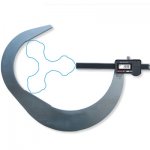Ox
Diamond
- Joined
- Aug 27, 2002
- Location
- Northwest Ohio
I am new to this design.
Has anyone used them?
TESA 36"- 40' OUTSIDE MICROMETER IN WOODEN CASE WITH STANDARDS | eBay
Are they more thermally stable from hand/heat transfer?
I'd guess no as the less material there is - the quicker it would be to warm up?
Maybe they are s'posed to be more rigid/pound to aid in handling/accuracies?
I see that SPI (MSC) has copied that basic design on their new ones.
SPI Electronic Interchangeable Anvil Micrometer 36”-40”/1000mm Range 13-498-1 | eBay
--------------------
Then there is this:
Scherr Tumico Micrometer 36"-42" inches | eBay
This has an interesting head unit on it.
That could be a good plan on these big (heavy) units, allowing two hands (with gloves) to handle the weight and manipulate the unit to get a consistant apex reading.
Has anyone used this design, and what is your experience?
I am quoting a 38" part and I only have mic's to 36", but I doo have a vern calipers that could possibly work.
--------------------
Think Snow Eh!
Ox
Has anyone used them?
TESA 36"- 40' OUTSIDE MICROMETER IN WOODEN CASE WITH STANDARDS | eBay
Are they more thermally stable from hand/heat transfer?
I'd guess no as the less material there is - the quicker it would be to warm up?
Maybe they are s'posed to be more rigid/pound to aid in handling/accuracies?
I see that SPI (MSC) has copied that basic design on their new ones.
SPI Electronic Interchangeable Anvil Micrometer 36”-40”/1000mm Range 13-498-1 | eBay
--------------------
Then there is this:
Scherr Tumico Micrometer 36"-42" inches | eBay
This has an interesting head unit on it.
That could be a good plan on these big (heavy) units, allowing two hands (with gloves) to handle the weight and manipulate the unit to get a consistant apex reading.
Has anyone used this design, and what is your experience?
I am quoting a 38" part and I only have mic's to 36", but I doo have a vern calipers that could possibly work.
--------------------
Think Snow Eh!
Ox







